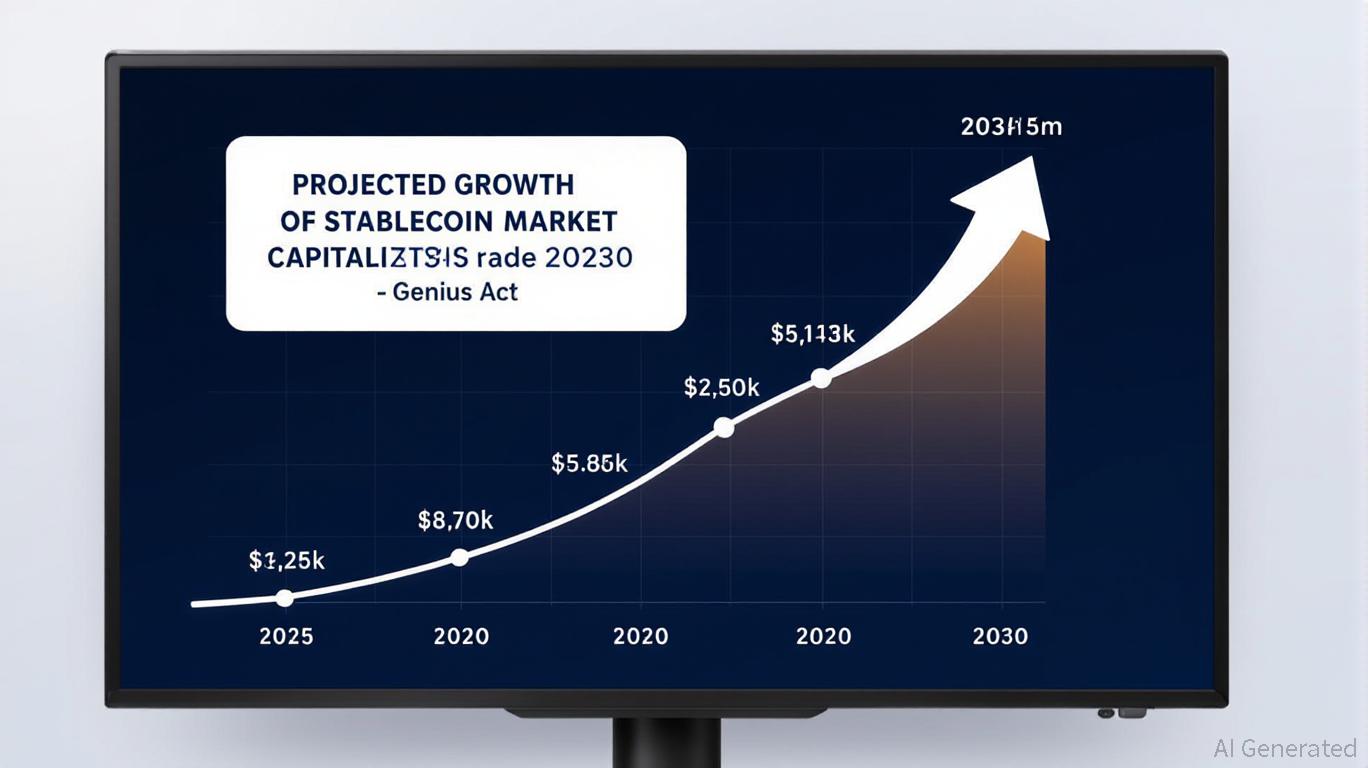AInvest Newsletter
Daily stocks & crypto headlines, free to your inbox
The GENIUS Act—formally the Guiding and Establishing National Innovation for U.S. Stablecoins Act—has redefined the regulatory landscape for digital assets in the United States. Signed into law on July 18, 2025, this legislation is more than a technical fix for stablecoins; it is a strategic pivot toward embedding blockchain technology into the backbone of the global financial system. For investors, the Act represents a seismic shift in how we evaluate innovation-driven portfolios, reshaping R&D incentives, startup ecosystems, and institutional capital flows.
The Act's core provisions mandate that payment stablecoins be fully backed by high-quality, liquid assets (HQLA) such as U.S. dollars, short-term Treasuries, or money market funds. This 1:1 reserve requirement, coupled with mandatory monthly disclosures and audits for large issuers, addresses long-standing concerns about transparency and systemic risk. By aligning stablecoin oversight with traditional banking standards, the Act creates a bridge between crypto and legacy finance, reducing the friction that has historically deterred institutional participation.
But the implications go beyond compliance. The Act's dual regulatory pathway—allowing state or federal oversight for stablecoin issuers—fosters competition while preventing regulatory arbitrage. This structure incentivizes innovation: startups can now experiment with cross-border payment solutions, tokenized real-world assets, and decentralized identity systems under a predictable legal framework. For example, fintech firms are already leveraging the Act's provisions to develop scalable infrastructure for programmable money, while banks are exploring stablecoin-based settlement networks to cut costs.
The Act's emphasis on compliance has inadvertently created a gold rush for R&D in regulatory technology (“RegTech”). Startups specializing in AML tools, reserve tracking, and smart contract audits are now in high demand. Consider the case of Mastercard's Multi-Token Network, which uses blockchain to settle transactions in multiple currencies while adhering to the Act's reserve requirements. Such innovations are not just compliance tools—they are the building blocks for a new generation of financial infrastructure.
For investors, this means opportunities in companies that enable compliance. Take ChainGuard, a blockchain analytics firm that recently secured $150 million in Series C funding. Its AI-driven AML platform is now a critical component for stablecoin issuers navigating the Act's stringent reporting obligations. Similarly, custody solutions like BitGo are seeing surges in institutional adoption as the Act mandates secure storage of stablecoin reserves.
The GENIUS Act has also recalibrated the startup ecosystem. Previously, stablecoin projects operated in a legal gray area, deterring venture capital from funding ambitious ideas. Now, with a clear path to compliance, venture firms are reallocating capital to stablecoin-adjacent technologies. The result? A surge in funding for startups focused on cross-chain interoperability, tokenized real estate, and decentralized identity systems.
Take the example of StablePay, a startup that recently launched a stablecoin-based B2B payment platform. By leveraging the Act's regulatory clarity, StablePay secured $200 million in Series B funding led by Sequoia Capital. Its success underscores a broader trend: startups that align their value propositions with the Act's goals—transparency, efficiency, and institutional-grade security—are outperforming their peers.
However, the Act's reserve requirements and licensing hurdles may also consolidate power among larger players. Smaller startups must now compete not just on innovation but on their ability to navigate a more complex regulatory environment. This creates a “winner-takes-all” dynamic, favoring firms with strong partnerships with traditional banks or access to federal charters.
Perhaps the most profound impact of the GENIUS Act is its effect on investor sentiment. For years, crypto markets were plagued by volatility and regulatory uncertainty. The Act's passage—backed by bipartisan support—has quelled many of these fears. Institutional investors, including
and Fidelity, have accelerated their crypto offerings, with BlackRock's spot ETFs drawing record inflows in Q2 2025.This shift is not limited to Bitcoin. The Act's emphasis on stablecoin infrastructure has elevated the profile of utility-driven altcoins like
and , which underpin decentralized finance (DeFi) and cross-chain applications. For example, Ethereum's staking rewards and smart contract capabilities now align more closely with the Act's focus on programmable, transparent financial tools.The GENIUS Act is a foundational piece of legislation that will shape the next decade of digital finance. For investors, it signals a shift from speculative trading to strategic infrastructure-building. The winners in this new era will be those who understand how to navigate the intersection of regulation, technology, and market dynamics. As the Act's implementation unfolds, the key will be to stay ahead of the curve—investing not just in crypto, but in the systems that make it work.

In the end, the Act is not just about stablecoins—it's about reimagining the future of money. And for those willing to look beyond the headlines, the opportunities are as vast as the blockchain itself.
Delivering real-time insights and analysis on emerging financial trends and market movements.

Dec.17 2025

Dec.17 2025

Dec.17 2025

Dec.17 2025

Dec.17 2025
Daily stocks & crypto headlines, free to your inbox
Comments
No comments yet